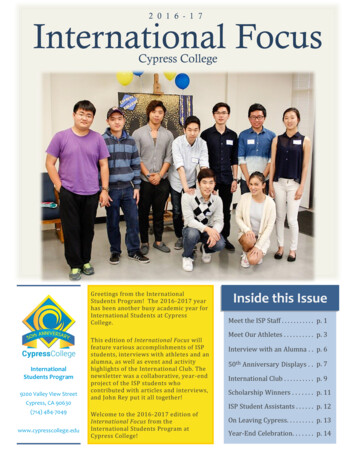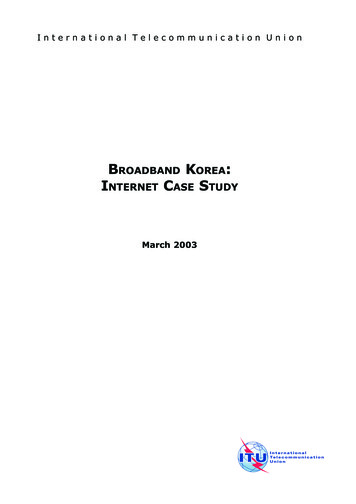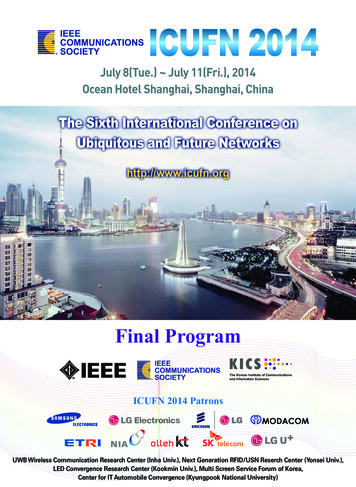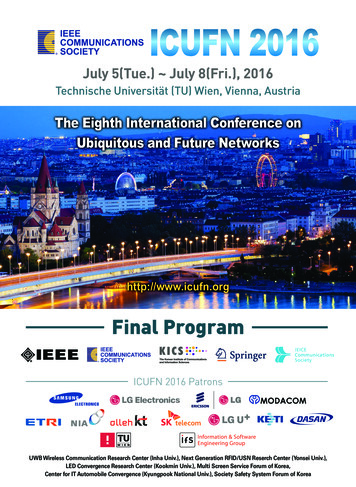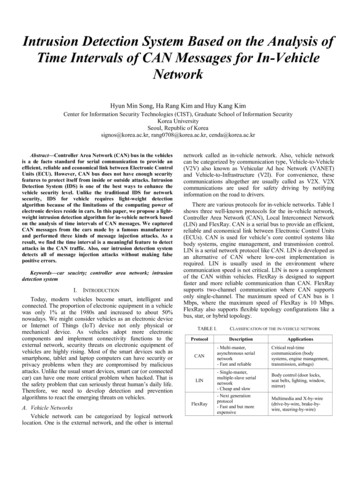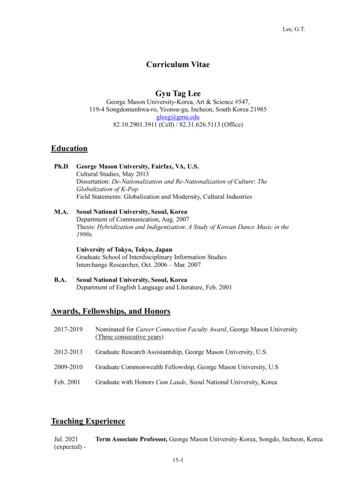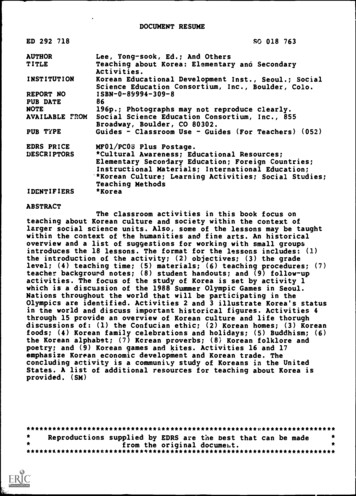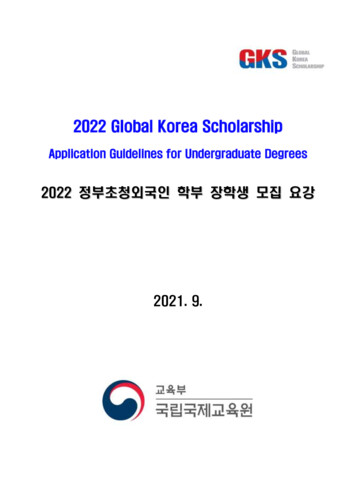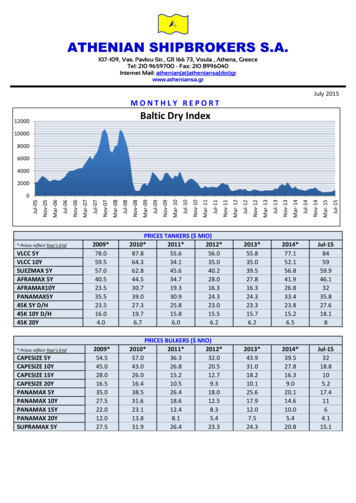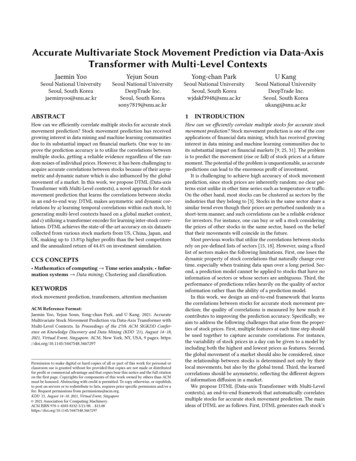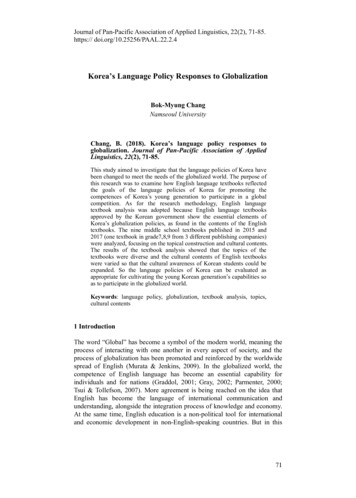
Transcription
Journal of Pan-Pacific Association of Applied Linguistics, 22(2), 71-85.https:// doi.org/10.25256/PAAL.22.2.4Korea’s Language Policy Responses to GlobalizationBok-Myung ChangNamseoul UniversityChang, B. (2018). Korea’s language policy responses toglobalization. Journal of Pan-Pacific Association of AppliedLinguistics, 22(2), 71-85.This study aimed to investigate that the language policies of Korea havebeen changed to meet the needs of the globalized world. The purpose ofthis research was to examine how English language textbooks reflectedthe goals of the language policies of Korea for promoting thecompetences of Korea’s young generation to participate in a globalcompetition. As for the research methodology, English languagetextbook analysis was adopted because English language textbooksapproved by the Korean government show the essential elements ofKorea’s globalization policies, as found in the contents of the Englishtextbooks. The nine middle school textbooks published in 2015 and2017 (one textbook in grade7,8,9 from 3 different publishing companies)were analyzed, focusing on the topical construction and cultural contents.The results of the textbook analysis showed that the topics of thetextbooks were diverse and the cultural contents of English textbookswere varied so that the cultural awareness of Korean students could beexpanded. So the language policies of Korea can be evaluated asappropriate for cultivating the young Korean generation’s capabilities soas to participate in the globalized world.Keywords: language policy, globalization, textbook analysis, topics,cultural contents1 IntroductionThe word “Global” has become a symbol of the modern world, meaning theprocess of interacting with one another in every aspect of society, and theprocess of globalization has been promoted and reinforced by the worldwidespread of English (Murata & Jenkins, 2009). In the globalized world, thecompetence of English language has become an essential capability forindividuals and for nations (Graddol, 2001; Gray, 2002; Parmenter, 2000;Tsui & Tollefson, 2007). More agreement is being reached on the idea thatEnglish has become the language of international communication andunderstanding, alongside the integration process of knowledge and economy.At the same time, English education is a non-political tool for internationaland economic development in non-English-speaking countries. But in this71
Bok-Myung Changprocess, the question of English leadership is still a controversial part.Globalization is characterized by technical and English skills. These twoskills are defined as literacy in the global era (Tsui & Tollefson, 2007, p.1).Each country is committed to improving its two capabilities to overcome thechallenges of the global era.Therefore, Korea’s education policy has been changed to focus ondeveloping the global capabilities of Korean students in order to meet thechallenges of the globalized world and to play a leading role in internationalaffairs (Kwon, 2000; Yim, 2007). This study aimed to show that Korea’slanguage policies have been changed to meet the needs of the globalizedworld, and the results were successful.2 Literature Review2.1 Language policy and English language curriculum in KoreaAccording to Chang (1996), the English education in Korea began in the late19th century as part of modernized education. This period was established bymodern educational institutions such as Dongmunhak, Yookyoung Park, andthe official foreign language school and during this period, Christian privateschools (the Ewha School, Baejae School, etc.) aimed at spreadingChristianity. This period is called the beginning of Korean English education.After that, Korea's English education took a step backward because ofJapanese colonization. Since the official curriculum was established in Korea,the English language contents of elementary, middle and high schools weredecided according to the atmosphere and needs of the society from the first tothe seventh period of the curriculum. In particular, as the 1986 Asian Gamesand 1988 Olympic Games were held in Korea, English language curriculumcontents were changed from grammar-focused teaching methods tocommunication-oriented methods. In the 6th curriculum, as Korea joined theOECD, the development of English proficiency in the era of globalizationwas clearly marked as the goal of English education. As such, around the1990s, all national policies were implemented to foster nationalcompetitiveness in globalization, among which English was beingemphasized as a tool for communication in the global age (Kramsch, 2014).South Korea has also made strenuous efforts to improve the nation'scompetitiveness for globalization. In 1995, during the Kim Young-samadministration, the government declared the "globalization era" as its goal ofnational policy to foster national competitiveness in response to theglobalization era, and among other things, it set the purpose of the nation'seducation. In the era of the 6th curriculum (1992-1997) and 7th curriculum(1997-2006), Korea's economic growth restored confidence and emphasizedthe need for the era of globalization and the international community for72
Korea’s Language Policy Responses to Globalizationeducation (Chang, 1999, 2001). To achieve the goal of English education inresponse to the needs of this era, the contents of the English curriculum weremuch transformed from the 6th national curriculum, including introduction ofcommunication-centered teaching subjects, reclassification of languagefunctions, level curriculum, and conversion to student-oriented curricula.Since the 1990s, the goal of English education has been to foster talentedpeople to meet the globalization era, so that elementary schools havedesignated English subjects, the education policies of Korean governmentdecided to directly hire native English teachers, and to introduce Englishlistening ability tests (Chang, 2009). The brief history of English education inKorea could be summarized by the following three phases (Chang & Han,2016).2.1.1 The first phase: the 1st 5th curriculum (1954 – 1992)This phase could be summarized as the period when Korea's first educationallaw was promulgated and the first educational process was established. Andthe changes in various aspects of Korean society were reflected in thecurriculum, and they went through the process of change almost every 10years. The specific focuses of the English language curriculum of the firstphase are as follows:·Focus on developing basic skills in grammar, the ability tounderstand each other's culture·High emphasis on introducing Korean culture through foreignlanguages·Promoting English education courses that emphasizecommunication skills by enhancing the basic skills of English2.1.2 The second phase: the 6th and the 7th curriculum (1992 – 2007)During this phase, Korea's economic growth helped Koreans to regainconfidence and Korea joined OECD and the demand for an era ofglobalization grew stronger. The Korean government highly emphasized thenational development and contributions to the international community.① The 6th curriculum (1992- 1997)·Reviewing student needs·High emphasis on human development process·Introduction of English subjects centered on communication·Introduction of methods and contents of priority for practicalavailability·Reclassification of language functions② The 7th curriculum (1997- 2006)·Introduction of constructivism in the English language curriculum73
Bok-Myung Chang·High emphasis on students' own learning skills rather than theform of education based on the structural education philosophy·Highlight communication skills and language skills·Recommending the education courses by level·High emphasis on performing activities through various learningtasks·Students-oriented curriculum·New awareness of our culture by understanding foreign cultureand promoting proper values2.1.3 The third phase (revised curriculum; 2009 - present)This phase could be summarized as the English language curriculumemphasized on cultivating the creative and talented global capabilities ofyoung Korean learners.① 2009 revised curriculum·Emphasis on a student-centered curriculum·Focus on making the contents of the curriculum appropriate andstrengthening the connectivity between each curriculum·Strengthening English education to improve practical Englishskills·Dividing the curriculum into common courses and selectivecourses② 2015 revised curriculum·Fostering learners' autonomous academic skills by reducing thelearning burden·Operating integrated education courses·Introduction of free semester system for middle school·Emphasis on developing the software classes·Reducing and simplifying the number of subject areas to 10subjectsThe brief developmental history of English language policies of Korea couldbe sketched through the above three phases. The first phase was meaningfulin that Korea’s first educational law was set up and the first educationalprocess was established. The second phase could be evaluated to highlyemphasize the national development and contributions to the globalizedworld. Now Korea reached the third phase of Korea’s English educationhistory, and the third phase focuses on cultivating the creative talents and globalcapabilities of young Korean learners. These three phases of English educationdevelopment show that Korea has set the purposes of English education and adaptedthe contents of English curriculum and textbooks considering the various factors ofthe social, economic, and political situations confronting Korea at that time.74
Korea’s Language Policy Responses to Globalization2.2 Theoretical backgroundAccording to the definition of Wikipedia, the concept of globalization can besummarized as follows: ‘Globalization is the process of interaction andintegration between people, companies, and governments worldwide.Globalization has grown due to advance in transportation and communicationtechnology. With increased global interactions comes the growth ofinternational trade, ideas, and culture. The term globalization derives fromthe world globalize, which refers to be emergence of an international networkof economic systems. The term ‘globalization’ had been used in its economicsense at least as early as 1981, and in other senses since at least as early as1944 (Wikipedia: https://en/ wikipeda.org/wiki/globalization)’. Global hasbecome a symbol of the modern world, meaning the process of interactingwith one another in every aspect of society, and the process of globalizationhas been promoted and reinforced by the worldwide spread of English(Crystal, 2003; Kramsch & Vinall, 2014; McCarty, 2010).After going through the 1986 Asian Games and the 1988 OlympicGames, Korea was exposed to the international community in the 1980s, andthe strong internationalization craze in the 1990s made English moreimportant in Korean society. With new technological advances, globalizationhas led to significant changes both domestically and nationally in all areas ofpolitical, economic and social culture. As Brown and Lauder (1997) pointedout, the education system is also part of the economic identity of society. Ithas become an important educational agenda for many countries, includingKorea, which raised a question of how to respond to the challenges caused byglobalization. One of the many challenges facing South Korea was how toteach students skills that could make them internationally capable: foreignlanguage skills, mathematical logic, scientific thinking, and computer skills.The most important of these abilities is English ability, as English serves asan important medium of communication as a lingua Franca whencommunicating through the Internet. It is true that English has become asurvival skill of the 21st century, both personally and nationally (Graddol,2001; Gray, 2002; Parmenter, 2000).Korea has made much effort to educate people about how to bringthe world's culture to Korea and also to respect other cultures (Kim. M. H.,2001). The challenge is to develop Korean students into people who can playa leading role in international business in response to the challenges of theglobalized world. In order to achieve this goal, Korea's main task is todevelop students who are proficient in English skills. At the same time, it isimportant for students to strongly recognize Korea's national identity,because Korean students must have the ability to introduce Korean traditionsand ethnic homogeneity to the world in English.In order to provide appropriate language education in the era ofglobalization, there have been active studies of language policy and culture in75
Bok-Myung Changthe field of education since the 2000s. Yim (2007) analyzed Englishtextbooks in order to prove the suitability of the Korean government'seducation policy to achieve the goal of fostering the talented young peoplesuitable for the global era. His study analyzed the composition and culturalcontents of each textbook by subject, selecting English textbooks for middleschools, which were written on the basis of the curriculum revised in 1995and have been used in each school since 2001. The analysis has shown thatthe English education policy of Korea has emphasized to develop the Englishlanguage skills that could embrace both national and internationalresponsibility for the sake of the globalization strategy to make Korea astronger, more developed and more influential country in the world. Inaddition, the English textbooks compiled to achieve these educational goalsplayed a very positive role in improving English skills, introducing a varietyof world cultures to Korea and introducing Korean values and traditions tothe world, while improving national self- esteem.English textbooks have been revised in accordance with theinternationalization policy set by the government. Textbooks are a goodbeginning for studying the impact of globalization on national identity,because an important element of internationalization policy is clearlyreflected in the contents of English textbooks. There have been importantstudies on the relationship between English language policies and textbooksin the 21st century. Tsui & Tolefson (2007) stressed the importance of thenation’s cultural identity and language policy in the global era, andemphasized the importance of the role and the status of English language inAsian countries. Tolefson (2013) discussed the importance of language policyin education area, and emphasized the relationship between language policyand ideology. The relationship between language policy and ideology hasbecome very crucial point in the study for multiculturalism and plays animportant role in controlling social and political conflicts. Ping (2014)analyzed the English policies reflected in Chinese elementary school Englishtextbooks. It analyzed the linguistic data expressed by various Chinesecultures, and investigated how these cultural displays were implemented inthe relationship between China and the global community. This study pointedout that current English textbooks are organized so that Chinese learners havea good sense of their own culture.The Korean government started revising English textbooks from the6th national curriculum to achieve the goals implemented by suchglobalization policies, designating English as a compulsory subject from thethird grade of elementary school from the 7th national curriculum (Chang,2009). Therefore, the purpose of the study is to demonstrate how textbooksadopted by the reform of education policy respond to the nationalglobalization strategy, Korea's national identity and the process of raisingself-esteem in Korea.76
Korea’s Language Policy Responses to Globalization3 Research MethodologyThe research method was to analyze the topical construction of the readingtexts in each lesson from 9 middle school textbooks (one book in grades 7, 8,9 from 3 different publishing companies: the textbooks of grade 7 werepublished in 2017, the textbooks of grades 8, 9 were published in 2015). Theauthor of this research analyzed the topics of each reading texts and categorizedthe topics into 4 groups: personal life, personal welfare, social matters, andcultural exchanges. Also the author narrowed down the scope of textbookanalysis into the textbooks from 3 different publishing companies. In thisresearch, total 87 lessons (grade 7: 24 lessons, grade 8: 32 lessons, grade 9: 31lessons; total 87 lessons) were analyzed according to three criteria:3.1 What was the topic composition of each textbook? Were thetopics constructed in order to improve the Korean students’ abilityto understand language and culture through various experiences?Could the topical construction reflect the cultural diversity enoughto provide the wide perspective for understanding the multiculturalism of the globalized era?3.2 Was the topical composition of the subject matter different foreach school year? Or were the topical constructions made up of thesame proportion from the 7th grade to the 9th grade textbooks?3.3 Were there any differences in the topical construction betweenthe English textbooks published on the 7th national curriculum andthose published on the revised national curriculum in 2009? Forthis question, this study compared the results of analyzing thetopical construction of the English textbooks by Yim (2007) andthe results of this research paper.4 Results and DiscussionIn this section, the results of analyzing the middle school English textbookswere summarized according to the topical construction of English textbooks,the distribution of topical categories in each grade of English textbooks, andthe comparison of the topical construction between English textbook on the7th national curriculum and those on the revised national curriculum.4.1 The topical construction of English textbooksThe topical construction of English textbooks based on the revisedcurriculum showed that English textbooks consisted of 19 topics, whichsignified that the topics were various enough to provide an extensiveperspective for the world to young Korean learners.77
Bok-Myung ChangThe most frequently presented topics in this textbook analysis includedthe topics of art, literature (related with creativity, imagination: 11.4%), thetopics of manners, public order, cooperation, voluntary work, responsibility, etc.(10.3%), and the topics of animals, plants, seasons, and weather (related withnatural phenomenon: 9.1%). As seen in Table 1, the researcher divided these 19topics into 4 categories (personal life (topics ① ⑥), personal welfare (topics⑦ ⑩), social matters (topics ⑪ ⑬), and cultural exchange (topics ⑭ ))according to the common characteristics of the topics.Table 1. Topical Analysis of Middle School English TextbooksCategoryTopicsNo%① Personal life55.7② Family life & food, clothing and shelter55.7③ School life & friendship55.7④ Social life & personal relationship22.2⑤ Good use of leisure (hobbies, travel, sports, etc.)7889.1PersonalLife⑥ Animals, plants, seasons, weather (related naturalphenomenon)⑦ Communication styles in English cultureCultural⑧ Daily life of English speaking people33.4Exchange⑨ Observation of cultural and linguistic differences55.7⑩ Introduction of Korean culture to the world66.8910.31011.455.7⑪ Manners, public order, cooperation, voluntarywork, responsibility, eativity,imagination)⑬ Career, job, work (related with one’s welfare)78
Korea’s Language Policy Responses to Globalization⑭ Environmental matters (related with 187100problems,withsocietychanges)⑯ Human rights, democratic citizenship, globalSocialMattersetiquette, the equality of the sexes (related withdemocratic awareness, world citizen awareness)⑰ Patriotism, peace, security, unification⑱ Liberal arts (politics, science, math, economy,history, geography, etc.)⑲ Academic knowledge related with humanity,social science, natural science, art)The most frequently presented topics could be ranked as follows:1) Art, literature (related with creativity, imagination): 11.4%2) Manners, public order, cooperation, voluntary work,responsibility etc.:10.3%3) Animals, plants, seasons, weather (related with naturalphenomenon): 9.1%4) Good use of leisure (hobbies, travel, sports, etc.): 8%5) Introduction of Korean culture to the world: 6.8%Also the frequency of topical categories could be ranked aspersonal life (36.7%), personal welfare (27.5%), social matters (19.5%), andcultural exchange (16%), and this result can be seen in Figure 1. Thissignified that the topical categories were appropriately constructed andwere not concentrated on one or two specific topical category.79
Bok-Myung Chang16.0%personal life36.7%personal welfare19.5%social matterscultural exchange27.5%Figure 1. The ranking of topical categories of English textbooks4.2 The distribution of topical categories in each grade of EnglishtextbooksThis study analyzed the distribution of the topical categories in each grade.The results of this analysis showed that the portions of topical categorieswere different in each grade and were appropriately presented according tothe grade. The distribution of topical categories in each grade could besummarized in Figure 2.1) Grade 7: Personal Life (50%) Personal Welfare (25%) Cultural Exchange(12.5%) Social Matters (12.5%)2) Grade 8: Personal Life (40.6%) Personal Welfare (37.5%) Cultural Exchange (12.5%) Social Matters (9.3%)3) Grade 9: Social Matters (35.4%) Cultural Exchange (22.5%) Personal Life (22.5%) Personal Welfare (19.3%)personal lifeGrade 7cultural exchage50Grade 8Grade 9personal welfare2540.622.537.519.322.5Figure 2. The distribution of topical categories in each grade80social matters12.512.535.412.59.3
Korea’s Language Policy Responses to GlobalizationAs we could see in Figure 2, in the textbooks for grade 7, 8, the topicsbelonging to personal life and personal welfare were more frequentlypresented than those of grade 9. But the textbooks for grade 9 emphasized thecategories of social matters and cultural exchange more than personal life andpersonal welfare. This implied that the topical categories of Englishtextbooks were well distributed according to the students’ grade. Thisdistribution could be evaluated as meaning that the educational polices ofEnglish language textbooks reflected the educational philosophy that as thelearners became older, they might be more concerned about social mattersand cultural exchanges than the younger learners.4.3 The comparison of the topical construction between Englishtextbooks on the 7th national curriculum and those on the revisednational curriculumThis study compared the results of topical construction analysis betweenEnglish textbooks based on the 7th national curriculum (Yim, 2007:44-47)and those based on the revised curriculum (2009). As seen in Table 2, therewere some differences among the ranks of topics presented in the Englishtextbooks. The most frequently presented topic in the English textbookspublished based on the 7th national curriculum were “Life in foreign countries”and “Life in Korea”, but English textbooks published based on the revisedcurriculum emphasized “art, leisure (related with creativity, imagination)”,“manners, public order, cooperation, voluntary work, responsibility etc.”more than other topics. This result implied that the English education policiesof the 7th national curriculum started to emphasize the life in the globalizedworld and the introduction of Korean cultures into the world, which wereclosely related with the fact that the topics of English textbooks wereconcentrated in “Life in foreign countries” and “Life in Korea”.Chang (2009) explained that in 1995, during the Kim Young-samadministration, the Korean government declared the "globalization era" as itsgoal of national policy to foster national competitiveness in response to theglobalization era, and among other things, it set the purpose of the nation'seducation. So the English textbooks published during the 7th nationalcurriculum reflected the hot fever of the globalization era, and thisatmosphere was reflected in the topic constructions of English textbooks.But the topical construction of English textbooks published based onthe revised curriculum (2009) was a little different from this trend. The topicswere so diverse and expanded that they included various topics related withgeneral cultures, and emphasized the importance of personal life and welfare,and natural phenomenon. This trend could be evaluated as being related withthe educational goals for diversifying cultural topics and contents in Englishteaching in the 21st century.81
Bok-Myung ChangTable 2. The Comparison of Topical Constructions between EnglishTextbooks Based on the 7th and the Revised CurriculumEnglish textbooks based on the English textbooks based on theTopics7th national curriculumrevised curriculumArt, leisure (related with1Life in foreign countries (17%)creativity, imagination) (11.4%)Manners,publicorder,2Life in Korea (12.3%)cooperation, voluntary work,responsibility, etc. (10.3%)Animals,plants,seasons,3Science (8.1%)weather (related with naturalphenomenon) (9.1%)Good use of leisure (hobbies,4Environmental Issues (6.2%)travel, sports, etc.) (8%)Introduction of Korean culture5Korea in the world (5.7%)to the world (6.8%)Table 2 shows that the frequency ranks of topical construction of Englishtextbooks based on the 7th national curriculum are a little different from thoseof English textbooks based on the revised curriculum. In the textbooks basedon the 7th national curriculum of Korea, the topics for “Life in foreigncountries”, “Life in Korea” were the most frequently introduced becauseduring the period of the 7th national curriculum, the globalization was the hotissue in the whole world, so the topics related with foreign countries andKorea were frequently introduced and debated in English textbooks. In thetextbooks based on the revised curriculum of 2015, the topical constructionchanged from the issues about globalization to the issues related with thepersonal life (art, leisure, etc.), and the personal welfare (manners, publicorder, cooperation, voluntary work, responsibility, etc.). This result can beevaluated with the fact that English education policy of Korea reflects thedemand of the 21st century, which focuses on the importance of personal lifeand welfare in order to prepare Korean young learners appropriate leaders inthe 4th industrial revolution period.5 ConclusionsBased on the results of English textbooks in this study, some summariescould be reached as conclusions. First, English textbooks based on therevised curriculum (2009) were constructed on 19 topics which were variousso that they could provide the extensive perspective about the globalizedworld to young Korean learners. The most common topics included the topicsof art, literature (related with creativity, imagination: 11.4%), the topics of82
Korea’s Language Policy Responses to Globalizationmanners, public order, cooperation, voluntary work, responsibility, etc.(10.3%), and the topics of animals, plants, seasons, and weather (related withnatural phenomenon: 9.1%).Second, the ranking of categorizing showed the results as follows:personal life (36.7%), personal welfare (27.5%), social matters (19.5%) andcultural exchange (16%). This result implied that the topical categories werewell balanced and were not concentrated on a specific area.Third, the distribution of each category was well established accordingto the grade. English textbooks for grade 7, 8 focused on personal life andpersonal welfare rather than social matters and cultural exchange, but theEnglish textbooks of grade 9 focused on social matters and culturalexchanges rather than on personal life.Last, there were some differences among the ranks of topics presentedin the English textbooks based on the 7th curriculum and the textbooks basedon the revised textbooks. The most frequently presented topic in the Englishtextbooks published based on the 7th national curriculum were “Life inforeign countries” and “Life in Korea”, but English textbooks publishedbased on the revised curriculum emphasized “art, leisure (related withcreativity, imagination)”, “manners, public order, cooperation, voluntarywork, responsibility etc.” more than other topics. This result signified that theEnglish education policies of the 7th national curriculum emphasized life inthe globalized world and the introduction of Korean culture into the world.This result was closely related with the fact that the 7th national curriculumwere applied during 1997-2006, when “the globalization fever” was the hotissue in Korea, so the English textbooks published at that time reflected thesocial atmosphere. But 10 years later, after the English curriculum in Koreawas revised in 2009, English language policy changed to focus on moregeneral themes and the topics related with the personal life and the happinessof human beings in the globalized world. This phenomenon could be seen asmeaning that the language policies of Korea are in harmony with the socialatmosphere in the second decade of the 21st century.Therefore, this study showed that Korea’s English language policyreforms in accordance with the globalized education purposes focused onintroducing diverse cultural and historical facts of foreign countries to youngKorean learners. Based on the findings of the study, Korea’s Englishlanguage policies could be evaluated to be in accordance with the globalizededucation purposes through introducing various cultures of the world intoKorea and constructing the historical Korean identity by promoting Koreanculture and tradition in the world.In the future, English language policies of Korea need to aim toconstruct a new Korean national identity that embraces both national goalsan
This study aimed to investigate that the language policies of Korea have been changed to meet the needs of the globalized world. The purpose of this research was to examine how English language textbooks reflected the goals of the language policies of Korea for promoting the competences of Korea's young generation to participate in a global comp.
